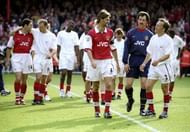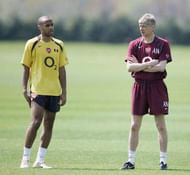‘Arsene Wenger and Arsenal Football Club’ is a love story that continues to go on and it’s been almost 21 years since the Frenchman arrived at the club and became an instant success. His managerial regime saw Arsenal become an English powerhouse as the club won three Premier League titles and six FA Cups under his guidance.
The team slowly became one of the most feared in English football and under Wenger, the Arsenal team won the Premier League without losing a single game and were called the Invincibles. He also oversaw the move from Highbury to the Emirates Stadium which was a move that showed the Gunner’s intent to be counted among the European elite.
However, Wenger is often not given the credit for the changes that he brought to English football as a whole.
At a time when the Frenchman is under pressure for failing to change over time, Sportskeeda brings to you 5 ways through which Arsene Wenger changed English Football for the good:
#1 New diet plans

Wenger joined Arsenal from Japanese club Nagoya Grampus in 1996. An interesting thing he noticed was the fact that the number of obese people was extremely less in Japan. The Frenchman realised that the staple Japanese diet of rice, boiled vegetables, fish and chicken were perfect for a modern footballer.
Back in those days, most of the teams used to rely on traditional English food items like red meat, chips, baked beans and fried food which were high in calories and did not offer the same nutritional content.
Wenger instantly ensured that a change in the nutrition plans took place. This did not mean that players were forced to eat these food items, however, it was strongly suggested at the same time.
The Frenchman also ensured that the training and diet did not go to waste as a lot of players had the habit of guzzling down copious amounts of liquor on the weekend. In a nutshell, Wenger’s arrival at Arsenal, changed how the club and English football dealt with nutrition and diet plans.
#2 Improved training regimes
Wenger was a perfectionist when it came to training sessions. The Frenchman was always the first to arrive and last to leave. David Platt, a former Arsenal player revealed that this was one area where Wenger was actually dictatorial in nature.
Things were extremely organised and detailed as the new manager ran everything according to his stopwatch. Not a single second was squandered and the team was on its toes throughout the training session.
Wenger also introduced a special muscle training exercise called plyometrics. This involved increased stress and tension on the muscles but also ensured that the results were much better.
Plyometrics was initially used by sprinters, hurdlers and long jumpers, but its introduction at Arsenal slowly saw the team become the fittest in the league. In fact, the Arsenal team trained so well that their game would always go a notch up during the death stages of a match.
#3 A league without borders
Arsene Wenger’s first Arsenal XI was filled with 10 Englishmen and the only foreign player in that team was French player Patrick Vieira. After joining Arsenal, the new manager established a robust scouting system in place. Back then, most English teams consisted of majorly English players and the league did not have an influx of foreign players.
However, Wenger’s appointment changed that significantly. Arsenal soon started investing in foreign-born talent and the returns were great. Wenger realised that the foreign football scene had a lot of players who were extremely talented but had gone unnoticed.
Most of these players also did not have a high transfer price since there was no demand for them. The low cost and the bundle of talent that these guys got in increasingly influenced how other teams indulged in their transfers as well.
In 2005, Wenger became the first manager to field a starting XI which did not consist of a single English player, although he was also criticised heavily for this.
#4 Foreign youth emphasis
Investing in youth was something Sir Alex had already tried and succeeded with the Class of 92, however, this was majorly local-born talent. Arsene Wenger was the first manager in the league who increasingly relied on not just English youngsters but foreign born as well.
The manager was always ready to give an opportunity to young players who show the hunger and desire to play at the top level. Whether it was Patrick Viera in the late 90s or Hector Bellerin in 2013, Arsene has not backed down from his youth philosophy.
Wenger’s reliance on the young players was evident after the club moved to the Emirates stadium as the manager had to make do with cheaper youth players since Arsenal did not have the financial capability to get the big shots in the world of football.
In Wenger’s words:
Building a top player is like building a house:(Foundation) technique – technical work is very important at this age and it’s what you look for, anything else is a bonus.(1st floor) physical – will they be quick and strong enough for top level football?(2nd floor) tactical – does he understand the game? How can I relate to you when you have the ball where do I go?(Roof) Mental – how much do you want to be successful? Disco on Friday night or rest for a game on a Saturday?
#5 Aesthetic football
Before the appointment of Arsene Wenger, Arsenal were often criticised for being a boring team as they often relied on the resilience and solidity of the backline to grind out victories. The ‘Boring Boring Arsenal’ era finished under Wenger who brought about a massive change in the way football was played at the club.
Arsenal slowly became one of the most attractive sides to watch as the team relied on speed and precision to deliver the results.
Whether it was the amazing counter attacking style of Arsenal’s Invincible team or the possession based football of the 2007-08 team, Arsene’s teams have always managed to delight the spectator with a beautiful game of football. The standard of football in the Premier League has improved a great deal after the Frenchman’s arrival at the London club.



